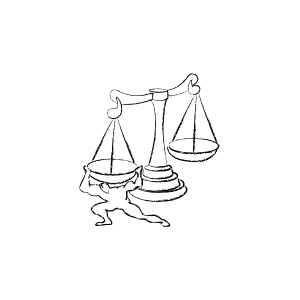Bump, set, & spike: Labor Discrimination Volleyball
One trend to follow in National Labor Relations Board (NLRB) case law recently is the ongoing controversy about a the generalized animus standard for the prima facia case in Wright Line burden-shifting discrimination cases under Section 8(a)(3) (union activity) and 8(a)(1) (protected concerted activity).
If that sentence made no sense to you, don't worry, it wasn't really in English. It was in the bizarre jargon only known to the small-and-ever-shrinking cabal of labor lawyers in America. Allow me to translate.
Wright Line in plain language
These cases are a little like a bizarre game of volleyball. First, the boss serves the ball by firing the employees. Then the ball is in the employees' court, and they have to send it back by providing enough evidence to show that the firing was motivated, at least in part, by animosity toward the union or free speech or other protected activity. To do this, initially, of course, the employees have to file a charge with the NLRB within 6 months. From there, they have to make three consecutive touches - like so:
- Proving that the employee engaged in union or other protected activity (bump!)
- Proving that the employer knew of such activities (set!)
- Proving that the employer harbored animosity towards the union or protected activity (SPIKE!)
If these three things are proven, then the employee has essentially spiked the ball back down over the net onto the employer's side, and the employer now has the burden of knocking it back, or the employer will lose.
To do this, the employer has to affirmatively prove that more likely than not they would have fired them anyway, regardless of the protected activity. This means the employer has to come up with the evidence to show they uniformly treated other employees that did not engage in protected activity in the same way. And if the evidence is only 50-50 or worse, the employer loses.
Proving antiunion animus
Often the most important part of this game is the spike
- proving employer animus. And the question of what exactly this means has been the subject of a number of recent Board decisions.
On March 30, 2015, for example, the Board issued a decision in Commercial Air, Inc., 362 NLRB No. 39, in which it stated that there did not need to be a particularized showing of animus towards the disciplined employee's own protected activity.
What this means is that the employee doesn't have to prove any sort of connection between the animus and the protected activity - or even the knowledge. As long as the employee engaged in any union activity, and the employer knew about it, you don't have to show animus toward the particular, known union activity at issue, you only have to show generalized animus - animus toward the union in general.
Member Miscimarra dissented on this point, stating that in his opinion the employee should have to prove a link or nexus between the employee's [known] protected activity and the particular decision alleged to be unlawful.
In essence, all three elements have to be both proven and tied together by a fourth element, "nexus," showing the connection between each of the three elements and the firing. This would be much harder to do, because it is very rare that the employer will say something specific to the particular employee's protected activity while firing them.
It also wouldn't make much sense, in my opinion. Where it is proven that the employer hates the union, and fired union organizers, it is perfectly reasonable to infer that the union organizing played some kind of role in the firing of these employees, and to put it to the employer to prove otherwise.
Last week's decision didn't exactly break new ground on this point. But the mere fact that it was addressed at all in Commercial Air, even though it made no difference in the outcome, shows the great care taken by the Board to ensure that nexus doesn't creep into Wright Line jurisprudence by casual misapplication in Administrative Law Judges. And as the dissent shows, the issue has been the subject of some second guessing recently. The Board discussed the issue a little more fully in Libertyville Toyota, 360 NLRB No. 141, slip. op at 4 fn. 10 (2014), where, as it noted, Member Miscimarra has taken up the mantle of former Member Schaumber in this quest to require a nexus. Member Schaumber failed to convince his contemporary colleagues (of either party) to adopt his view, and to date Member Miscimarra has fared no better.
Nonetheless, it is an issue that bears close attention, particularly because other statutes have been interpreted consistent with the Schaumber/Miscimarra view, and it could prove appealing to a future Board or to the Supreme Court.



Pursuant to MRPC 7.4(a)(2) FREE BACKGROUND INFORMATION AVAILABLE UPON REQUEST
This site is for general information only, and creates no attorney-client relationship. Sending inquiries to the firm does not create an attorney-client relationship. By calling or emailing the firm, you are consenting to receive return calls, emails, mailings and text messages from the firm.
To get legal advice about an employment law, labor law, federal employee law, whistleblower protection, labor unions, worker cooperatives, immigration, discrimination, harassment, wrongful termination, severance, or any related question, you must first have a conflicts check by the firm. We represent exclusively workers, worker cooperatives and unions, but we still must check for potential conflicts of interest, for example, between a supervisor and employee.
First provide the firm with your name, and the name of the person you are making claims against. This allows the firm to check for such conflicts of interest. Until you receive confirmation that there is NO CONFLICT, none of the information you provide will be considered confidential. Do NOT provide any confidential information before we have asked you to do so.
Once we have confirmed there is no conflict, you may discuss your matter with staff in a little more detail, and, if requested, make an appointment. If at your appointment the firm accepts you as a client in writing, then the attorney will be able to provide you with employment law advice.
.
.
.